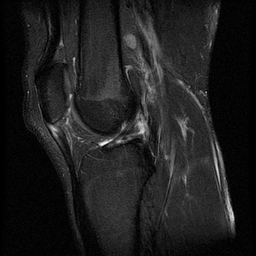| UW MSK Resident Projects |
|
|
|
|
Jumper's KneePrint-friendly version of this pagePosted by bmikysa@u.washington.edu, 10/13/04 at 11:00:14 AM.
Also known as patellar tendinitis. Relatively common cause of pain in the inferior patellar region in athletes. Begins as inflammation in the patellar tendon where it attaches to the patella and may progress by tearing or degenerating the tendon. Overuse injury from repetitive overloading of the extensor mechansism of the knee. Microtears exceed the body's healing mechanism unless the activity is stopped. Occurs in many athletes, but is most common in sports such as soccer, volleyball, or basketball which require explosive movements. Early stages may be treated conservatively. Uncommonly may require surgery to remove myxoid degeneration in the tendon. This is reserved for patients with debilitating pain for 6-12 months despite conservative measures. MR findings: Thickening of the proximal patellar tendon with high signal in/around the proximal patellar tendon on T2W images.
References:
|
|
